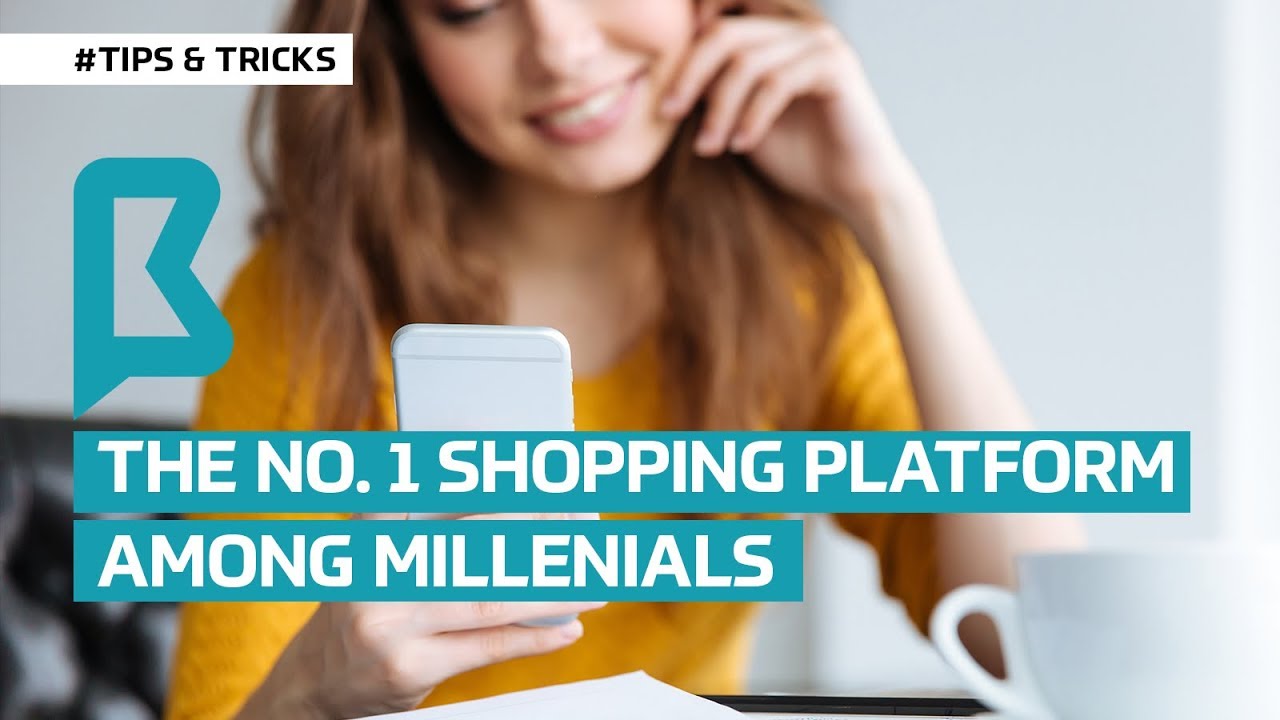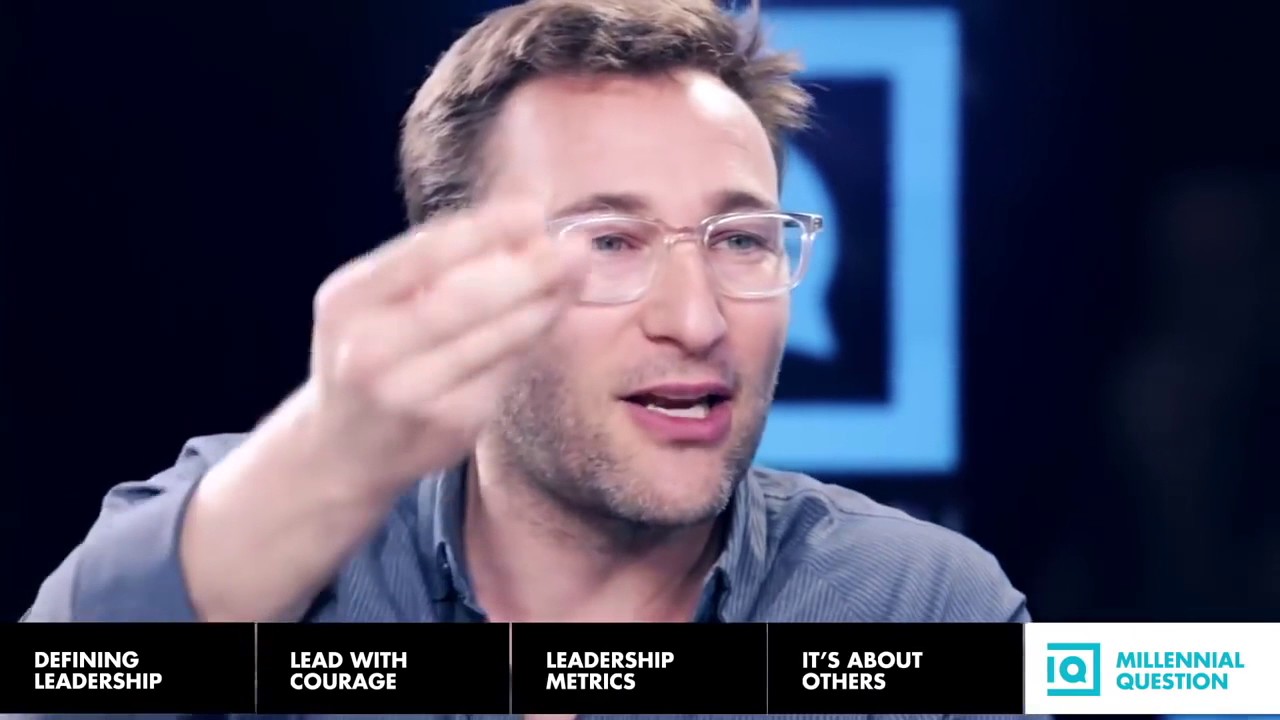Is TikTok replacing Google in search? Yes, according to Google itself
Senior Vice President Prabhakar Raghavan, who runs Google’s Knowledge & Information organisation, mentioned in a conversation at a tech conference earlier this year, that the search behaviour of young people, especially Gen Z and Alpha is changing.
He said this:
In our studies, something like almost 40% of young people when they’re looking for a place for lunch, they don’t go to Google Maps or Search. They go to TikTok or Instagram.
FORTY PERCENT.
TikTok picked up on this change in behaviour faster than Google and is adjusting accordingly.
What’s TikTok’s primary goal?
To keep users on its platform as long as possible.
TikTok and all the other social media platforms are looking for ways to make users’ experiences so fun that they don’t WANT to leave. They are also searching for new ways to cater to users’ every need so they don’t HAVE to leave. Looking for a new exciting place to eat out? Don’t need to search on Google, you can search on TikTok!
TikTok’s latest update confirms its focus on developing its search feature
To support this new behaviour, TikTok recently announced that its latest update allows users to post up to 2,200 characters in a video description. This means that with more text TikTok can better index search results.
With the average user spending almost 2 hours on TikTok as per Sensor Tower and Gen Z spending nearly 3 hours according to eMarketer, it’s a golden opportunity for marketers to get on the app and create content for the relevant keywords.
Here’s another statistic relevant to the amazing influence of TikTok on its users: there are over 24 billion views of #TikTokmademebuyit with users buying all sorts of products ranging from cat brushes to levitating light bulbs.
For some of these products, TikTok was a powerful sales generator after they went viral.
Like Clinique’s Black Honey Lipstick, which launched fifty years ago. Last year it was discovered by Gen Z and went viral on TikTok causing it to sell out in every store, including Clinique. Check out #cliniqueblackhoney, it has over 83 million views.
Another product that blew up on TikTok, also from the makeup vertical, is Maybelline’s Sky High Mascara. Where did it originate? A short analysis shows that it might have begun with this user trying the product on. Her video has 1 million views, the #skyhighmascara has now 711 million views.
Users searching for products and services on TikTok instead of Google coupled with TikTok giving users bigger video descriptions have huge implications for B2C brands. If you are a marketer working with B2C brands, take a closer look at TikTok and ask yourself and your team these questions:
Is our customer base on TikTok?
After seeing our product on TikTok, will they go I gotta have it!
Are there influencers with engaged communities relevant to our product? Should we work with them?
Should we build a community on TikTok yourselves or rely exclusively on influencer-led campaigns?
Before making a decision, here are 2 more insights to provide further guidance:
TikTok Communities
Surprisingly, #comedy (1722 billion views), #makeup (307 billion views) and #fashion (185 billion views) are not the only growing communities.
You should also know about #BookTok, the TikTok community where users share their favourite books. Videos labelled with this hashtag have 79.5 billion global views.
Recently TikTok announced a new feature dedicated to book lovers in this community developed in collaboration with Penguin Random House. “This feature allows users to link their favourite Penguin Random House books within their videos. Clicking the link directs people to a dedicated page with details about the book, including a brief summary, and a collection of other videos that linked the same title,” said TikTok in their announcement.
#momsoftiktok is another community of engaged creators with 144 billion views. Surprising, isn’t it? Gen Z is not the only generation on TikTok, Gen Xers and Millennials are on the app too.
Does your product fall in any of these categories?
If it does, log into TikTok and see what creators in these communities are talking about.
What are TikTok creators looking for?
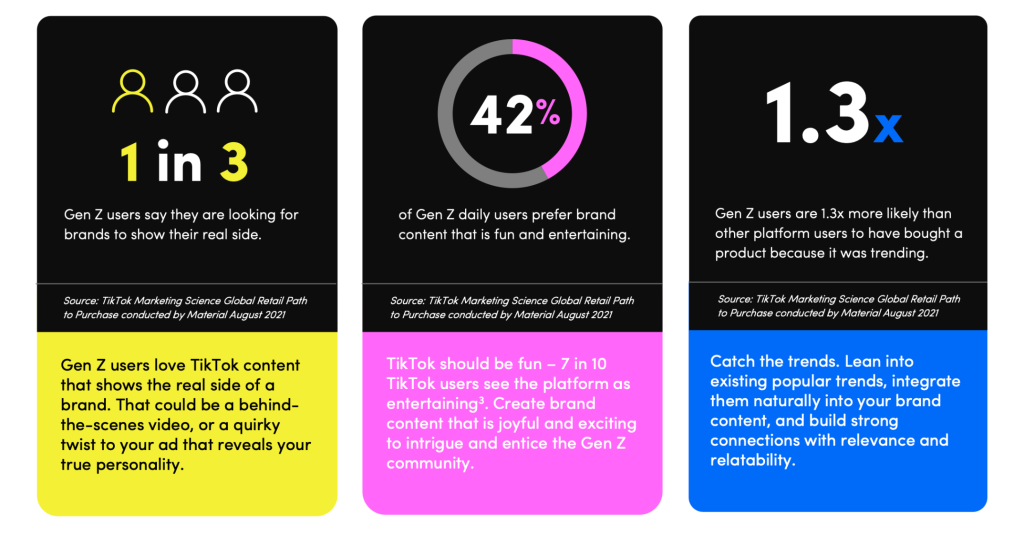
Gen Z TikTokers are using the app to express their creativity and find inspiration.
They are also more likely than other TikTok generations to discover new brands and products on the platform.
And another insight from TikTok: they love creating tutorial videos about their favourite finds.
What they expect from brands is to be authentic, entertaining (which doesn’t mean doing comedy) and show real people.
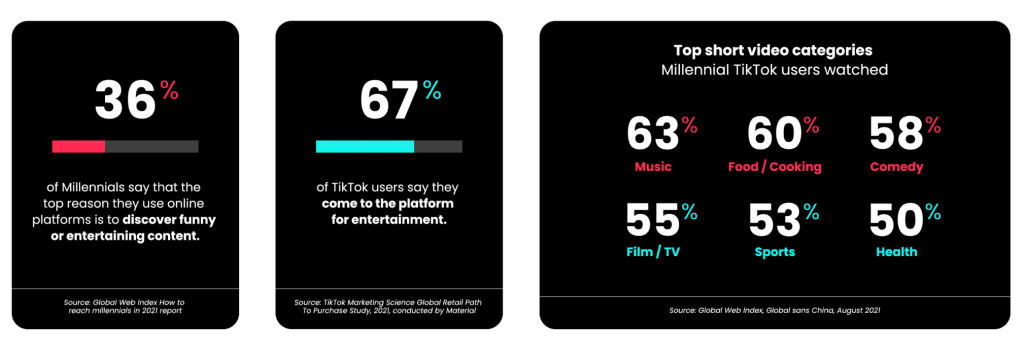
Millennial TikTokers go on TikTok to watch entertaining content and content that aligns with their interests.
6 in 10 Millennials on TikTok are parents so they are also watching videos related to parenting (#momsoftiktok, 144 billion views).
Other video categories include music (63%), food/cooking (60%), comedy (58%), film/tv (55%), sports (53%) and health (50%).
108 top insights on Generation X, Y, Z and Alpha
Are you looking to know more about Generation X, Y, Z and Alpha? Read on to discover 108 insights on Generation X, Y, Z and Alpha on several criteria like family values, career, consuming habits, communication, aspirations, fears and challenges, social interactions and psychological profile.
GENERATION X or Gen Xers (1965 to 1980)
Family values – Gex X values work-life balance
1.Gen Xers are family-oriented, financially responsible and self-reliant.
2. They value a healthy balance between time spent at work and personal time and want to pursue their own aspirations.
3. They enjoy leveraging the power of new tech in their adult years, but they also remember what the world was like before the rise of the internet and the digital revolution. In that sense, Gen Xers are the generation who transitioned from analogue to digital.
4. People born in the late 1970s – early 1980s are the latchkey generation or the MTV generation because they learned to entertain themselves in the hours between coming home from school and parents coming home from work.
5. Growing up in the 80s, with the largest divorce rate in history, a big number of the Gen X cohort grew up with a divorced parent.
6. While Gen Xers may not have had a great relationship with their parents growing up, now, in their adult years, they see their parents as older friends.
7. As parents, Gen Xers vowed to avoid making the same mistakes as their parents and learned to do better in the relationship with their children.
8. Gen Xers marry later in life, once their careers and finances are more established and stable. They divorce less (36%) than their parents (48%) but more than Millennials (26%) (source).
Education – Gen Xers are eager to learn
9. The members of Gen X are often noted as prioritizing self-directed educational opportunities and programs that enable them to learn on their own schedule.
10. They have benefited from traditional education by attending in-classroom lessons and writing on the blackboard. The internet and the digital revolution led to the rise of new jobs requiring new skills.
11. Gen Xers are the first generation to acknowledge, sometimes with sadness, that their formal education is no longer enough. They are the first to embody the growth mindset and live out the adapt or die concept.
12. Xers want to keep moving forward by developing a wide variety of skills that keep them employable.
13. The members of Gen X are prioritizing continuous learning in the form of microlearning. According to this survey, almost 37% said it was very important that the hiring company provide training to update their skills and/or knowledge.
Career – Gen Xers work to live, not live to work
14. Gen Xers are financially stable, are at their highest-earning years and are on their way to reaching the top of their profession. Making smart decisions for their family’s safety and financial future is very important to them (source).
15. Gen Xers believe that you need to plan your career, or you might not have one. What can Gen Xers offer employers? A wealth of knowledge, experience and stability. What are Gen Xers expecting from employers? Development opportunities and leaders who exemplify the company’s values with their actions.
Consuming habits – Gen Xers are looking for discounts and loyalty programs
16. Gen Xers grew up before Amazon and the online shopping experience. However, they have now fully embraced e-commerce although they still enjoy an in-store shopping trip.
17. They are known to conduct online research at home and then shop in person, while their younger counterparts conduct research on their phones, in the store. They turn to Google to direct their purchasing decisions.
18. They’re also known to be very loyal customers with a high appreciation for value discounts and loyalty programs. They read product reviews, expect great customer service and are moved by nostalgia-based marketing.
19. The preferred social media platform of Gen Xers is Facebook where they connect with family and friends. Although highly tech-reliant, the members of Gen X are considered digitally conversant, but not digitally native.
20. Gen Xers buy products that are unique and high-quality, as opposed to Generation Y and Z who buy based on community and value (source).
Communication – 55% of Gen Xers use WhatsApp
21. Gen X was the first generation to incorporate digital technology in their youth. Generation X prefers receiving and using short, brief messages as opposed to lengthy ones (source).
22. The ability to utilize forms of digital technology enables Generation X to connect with younger people, such as Millennials or Generation Z.
23. They appreciate informal and flexible communications with 55% using WhatsApp.
Aspirations/Fears/Challenges – The average successful startup founder is a Gen Xer
24. The average age of a successful startup founder is 45 per this study, which makes the younger members of Gen X the most entrepreneurial of all generations.
25. Gen Xers fear not being adequately prepared for major leadership roles and not having time for their families and personal lives (source).
26. They fear being overlooked and replaced by Millennials in the workplace. They also fear they are not as prepared for retirement as their parents were. One of their goals is to become debt-free.
Psychological profile – Gen Xers don’t let negative feedback stop them
27. Gen Xers are independent, flexible, self-reliant critical thinkers. They are technologically adept, flexible and highly educated.
28. The members of Gen X are resourceful since they have been accustomed to caring for themselves and younger siblings since before reaching adulthood.
29. They value freedom and responsibility and try to overcome challenges on their own (source).
30. Generation X is more direct than the members of the other generations. They embrace feedback and don’t get hung up on negative feedback like the Millennials.
GENERATION Y or Millennials (1981 to 1995)
Family values – My child is one of my best friends
31. Millennials want different lives than their parents. On average, they have delayed or forgone marriage than previous generations and have been somewhat slower in forming their own households (source).
32. According to this report, when Millennials become parents, they take on a more intimate, less hierarchical role with their children than parents of previous generations. To that end, they want an open, honest dialogue with their children. In fact, nearly 8 out of 10 millennial parents agree that their child is one of their best friends.
33. For 95% of Millennial workers, finding a work/life balance is important.
Education – Skill development is crucial for the Millennial’s career
34. A greater number of Millennials have received a university education than the members of Generation X, meaning they can obtain higher-paid roles earlier in their careers.
35. 93% of Millennials find skill development crucial for their career.
Career – Money, security and time-off
36. Millennials are the largest generation in the modern workforce and are making more money than the workforce as a whole.
37. An increasing number of them are reaching executive and director level and have more cash coming in than ever before (source).
38. The next most successful entrepreneur behind the Gen Xer is the Millennial. Per this report, 84% of Millennials revealed that they are more satisfied as an entrepreneur than when they worked for someone else.
39. When they are not starting their own business, Millennials work full-time. According to stats, 73% of Millennials have full-time jobs. However, employed Millennials still look for getting a little extra money. 28% of employed millennials reported having a side hustle, and 61% of them made extra money on a weekly basis. 75% of Millennials prefer working from home and working remotely.
40. What do Millennials prioritize when looking for a job? Money, security and time-off.
Consuming habits – Millennials desire “experiences over things”
41. Millennial consumers are the largest generation and hold the most spending power – with a projected $1.4 trillion tab (source). Millennial high earners are those raking in at least $100,000 a year.
42. Some of this cohort had saved up to $3,000 a month during lockdown last year and now they are looking to spend big on travel. Millennials comprise the highest rate of luxury bookings (trips costing at least $5,000).
43. The consumption habits of Millennials are driven by their values or morals.
44. According to this survey, the top three goals for Millennials with a financial plan are debt repayment (57%), travel (48%) and increasing the amount they save for retirement (45%).
Social relationships – Millennials believe in changing communities
45. The millennial generation is conscious at all levels.
46. They want to save their money and invest in a socially responsible manner because they believe in changing communities. They are more racially and ethnically diverse, which has helped them support and fight for equality and human rights.
47. Millennials care most about civil rights/racial discrimination, healthcare, education, and employment (source).
Communication – Millennials like infotainment
48. 41% of Millennials prefer electronic communication. They are always on social media communicating and engaging in conversations that resonate with their interest.
49. Millennials appreciate authentic and fast communications with a preference for using text, chat, email and Instagram; they value efficiency and a digital-first approach.
50. Social media platforms are where Millennials receive their news and other important information.
51. Millennials are less likely to trust and show loyalty to companies that sound corporate and generic. They prefer brands that look, act, and sound friendly, cheeky, and personable.
52. Millennials are influenced by infotainment — content that both entertains and informs. If a brand engages with a millennial on a social network, the millennial is 62% more likely to become a loyal customer.
Aspirations/Fears/Challenges – Millennials are looking for purpose and fear failure
53. Millennials want to do something with their life other than just earn a living. They are interested in the problems of the world, like climate change, animal extinction, and GMOs.
54. They want to get involved and find their purpose by being inspired by the change they want to make (source). Six in 10 millennials say that a “sense of purpose” is part of the reason they chose their current employer (source).
55. The Top 3 goals of Millennials according to Statista are owning their own home, financial stability and travelling.
56. Millennials expect to lead a more balanced life than previous generations. Private life and leisure activities are very important to them. They believe that to be good at work, they need to be happy in their life.
57. Their greatest fears related to work-life are getting stuck with no development opportunities (40%), not realizing their career goals (32%) and not finding a job that matches their personality (32%).
Psychological profile – Looking for a healthy lifestyle
58. More Millennials consider mental and physical health an essential expense than did baby boomers and Gen Xers (source)
59. Compared to the previous generation, Millennials focus on larger societal needs rather than individual needs.
60. Travelling the world is the highest priority for 57% of Millennials.
61. Millennials care about experiences (they expect genuine and incredible experiences and want to build lasting memories), values and purpose.
62. Studies show that millennials are leading the way when it comes to developing a healthy lifestyle and making good choices.
GENERATION Z or Gen Zers (1996 to 2009)
Family values – Gen Zers are influencing family decisions
63. Kids and teens today are members of Generation Z or Gen Zers. They grow up in a single-parent or dual-income household. But whether or not they live in a traditional family, parents of Gen Zers have less time. They often rely on their children to help them make purchase decisions.
64. Given the members of Generation Z have 24/7 access to information thanks to social media and a natural inclination to learn and explore, most parents happily delegate product research to their offspring.
65. What decisions does Gen Zers influence? Fast food restaurants and breakfast foods for their families, followed by snack and lunch foods, recreational activities, in-home entertainment and vacation destinations (source).
Education – On track to be the most well-educated generation
66. Members of Generation Z are on track to be the most well-educated generation yet and also more likely to have a college-educated parent than are previous generations of young people.
67. Because of this, they are more likely to be engaged in educational endeavours for a longer period of time than previous generations when they were teens and young adults (source).
68. They are also the first digital natives.
Career – Failure helps Gen Zers learn and grow
69. The most in-demand job that Gen Z job seekers are applying to is software engineer followed by software developer.
70. Gen Zers are aspiring to work in tech — the majority of job applications from Gen Zers were for companies in the tech industry, followed by business services, finance and retail. IBM, Google, Amazon, Microsoft and Deloitte are the top five companies that Gen Z are applying to. As digital natives, the members of Generation Z are drawn to search for jobs at tech companies.
71. What is Generation Z looking for when searching for a tech job? Good work environment, flexible hours, free food and company discount (source)
72. This generation prioritizes job security.
73. One refreshing aspect of Generation Z workers is their attitude about failure. While most other generations view failure as something to avoid, members of Generation Z are energized by failure.
74. According to one study, 80% of Generation Z sees failure as something to embrace on their way to more innovation and learning within a project. In fact, failure helps them learn and grow (source)
75. Gen Z is rapidly becoming known as the most entrepreneurial generation ever, with 62% of Gen Zers indicating they have started—or intend to start—their own business.
Consuming habits – Gen Zers’ purchasing decisions reflect their values and identity
76. They are shrewd consumers. As consumers, Gen Z rely on their tech savvy and extensive social networks to make informed purchasing decisions.
77. Their pragmatism leads them to explore and evaluate a range of options before settling on a product.
78. They also look at their purchasing decisions as an expression of their values and identity. As an example, they are drawn to sustainable products and brands — and are often willing to pay more for them.
79. They value personalized products, and they are drawn to brands who share their point of view on political issues (source).
80. Members of Generation Z spend more money than Millennials and are more than happy to browse in-store instead of online.
81. Material value may hold stronger resonance with Gen Z, as “Gen Z seems to be more drawn to things than the Millennials are, and they are keen to buy apparel and fashion accessories for themselves.”
Social relationships – Video and virtual dating are important to Gen Zers
82. When it comes to relationships, Generation Z is fully aware of what they want and do not want and have a general understanding of “toxic” traits they refuse to overlook. Unlike past generations, it is important for Gen Z to have a deeper emotional connection with their partner. Here are some statistics per this survey:
83. 21% of Gen Zers say a texting conversation can count as a date.
84. 51% say video and virtual dating are important.
85. 65% say dating websites and apps allow them to date someone outside of where they live.
86. 85% use YouTube.
87. Gen Z turns to YouTube to learn something.
88. 84% said they feel overwhelmed by the work and activities they have to do and turn to YouTube to decompress.
Communication – Gen Zers express their emotions through emojis
89. Generation Z appreciates visual communications with a preference for using face-to-face.
90. Their favourite social platforms are Snapchat, YouTube, TikTok and FaceTime.
91. They value video, voice command and a mobile-only approach.
92. Surprisingly, over 70% of Gen Z want to communicate face-to-face at work. They will continue to weave in and out of the digital channels they are accustomed to while seeking more face-to-face encounters.
93. 83% of Gen Z users are more comfortable expressing their emotions through emojis than a phone call, compared to Millennials (71%), Gen X (61%).
94. Roughly half of Gen Z adults (49%) get most of their news from social media. Gen Z adults are more likely to use digital-first news publications such as Buzzfeed and the Daily Mail on a weekly basis, relative to older Americans.
Aspirations/Fears/Challenges – Important life goals of Gen Zers: making money and having a successful career
95. 70% of Gen Z adults say making money and having a successful career are the two most universally important life goals – more than pursuing friends, family, or hobbies.
96. Gen Z adults are more likely to define themselves by what they do, rather than who they are.
97. 23% of Gen Zers say being famous is important to them – eight points higher than Millennials and 15 points higher than Gen X.
Psychological profile – Mental health challenges and feeling responsible to shape a better future for all
98. Members of Gen Z are more likely than older generations to look to the government to solve problems, rather than businesses and individuals.
99. Mental health challenges are a sad characteristic of Generation Z, which has been referred to by some as the “loneliest generation,” as their endless hours spent online can foster feelings of isolation and depression.
100. Additionally, many young people fall prey to the “compare and despair” trap that social media presents.
101. Gen Z kids also find their mental health affected by the turbulent state of the world. As political activism among Gen Z has increased, many Gen Z-ers have internalized the unrest surrounding issues like gun control, police brutality and climate change — leading to increased levels of stress.
102. Early signs indicate that they will grow into engaged, conscientious stewards of our world — by being socially-minded, independent thinkers, who recognize their responsibility in shaping a more equitable future for all (source).
GENERATION ALPHA (2010 to 2024)
103. Born to Millennial parents, Generation Alpha have a digital footprint before they can even walk. Celebrity kids like Prince William’s son George already have Instagram accounts, managed by their parents. Screens are placed in front of them from the youngest age as pacifiers, entertainers and educational aids.
104. Generation Alpha is the first group who will be immersed in technology their entire lives. These kids are also referred to as the Glass Generation as their glass-fronted devices will be their main medium of communication.
105. Alpha kids are expected to have a strong influence on the shopping behaviour of their Millennial parents, who are willing to spend a lot on their children.
106. Businesses will have to adapt to radically new ways of interacting and communicating with Alphas, compared to their parents.
107. Generation Alpha’s consumer experience will have to be seamless and integrated, with a personalised online experience. This will provide new opportunities for marketers.
108. They will stay in education longer, start their earning years later and so stay at home with their parents later than even their predecessors, Gen Z and Gen Y (source)
Join the Conversation
We’d love to hear what you have to say.
Get in touch with us on our LinkedIn Page, Facebook Page, Twitter or TikTok.
5 reasons for the failure of Thomas Cook, the world’s first travel agency
Table of Contents
Founded in 1845, Thomas Cook is the world’s first travel agency. A few years ago, the company was one of the world’s leading leisure travel providers operating in 17 countries, owning a fleet of aircraft and operating thousands of hotels around the world.
In 2019, the world watched its longest-running travel agency admit failure.
Let’s start from the beginning.
Thomas Cook – a short timeline
1845
Thomas Cook is an English businessman, who worked as a gardener and cabinet maker. He arranges for a party to travel from his hometown Leicester to Liverpool by train. Thus the world’s first travel agency is born. In 1846, he takes 350 people from Leicester on a tour of Scotland. A few years later he arranges for 150,000 people to travel to the Great Exhibition in London.
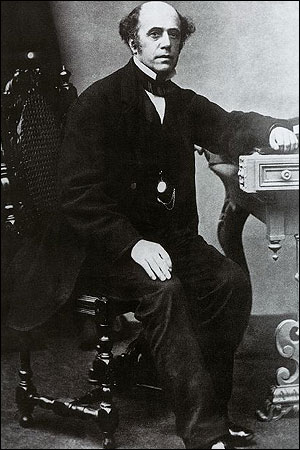
1855
In 1855, he plans his first continental tour, taking two groups on a grand tour of Belgium, Germany and France. The agency offers a complete package with its price including travel, accommodation and food, the first-ever of its kind.
1865-1866
The agency opens its first high-street shop in London. In 2019, the year of the collapse, the agency owns about 560 travel stores in the UK.
Thomas Cook’s son, John Mason personally conducts the company’s first American tour.
1872
Thomas Cook organizes the world’s first round-the-world tour. In the years to come, the company plans various tours to far-flung locations all over the world, including safaris in Africa. The company also expands into air and sea tours.
1965
The company’s net profits exceed £1 million for the first time.
1995
Launches thomascook.com, the first UK retail travel agency to offer customers a way to buy holidays online.
2000-2018
The company makes a series of acquisitions and mergers to extend its market share. The downside: acquiring a large debt.
2019
Royal Bank of Scotland, one of the company’s funders and a range of other banks demand that Thomas Cook Group PLC find $250 million in funding to ensure operations were protected.
The company’s management turned to the UK government for financial rescue. The UK government rejected its request.
Peter Fankhauser, Thomas Cook’s CEO, apologized to customers, employees, suppliers and partners and said the company “had no choice but to take steps to enter into compulsory liquidation with immediate effect” after talks on a financial rescue failed.” “This marks a deeply sad day for the company which pioneered package holidays and made travel possible for millions of people around the world.”
The group’s operations ceased immediately leaving around 600,000 tourists overseas including 150,000 British citizens.
It was the UK’s biggest peacetime repatriation.
Here’s another example: 4 reasons why fashion retailer Forever 21 went bust.
Thomas Cook – The scale of its collapse
Before entering into compulsory liquidation in 2019, here is an overview of Thomas Cook’s business:
- Thomas Cook Airlines owned a fleet of 93 aircrafts.
- The company employed approximately 21,000 staff worldwide, with 9,000 in the U.K.
- The agency offered its services in 17 countries either through its own branches or brand partners.
- Thomas Cook Group operated 3,170 hotels across 47 destinations.
- The group was the 2nd largest travel agency in Europe.
- Made EUR 9.5B in sales in 2018.
- Served 20 million customers every year.
- The company offered seven travel-related services: flights, hotel accommodation, cruises, foreign exchange, travel insurance, holiday packages, and one-stop shops, essentially meeting every need of its customers, from A to Z, with in-house resources.
Brand values: “Thomas Cook‘s promise to its customers is to be personal, trusted and innovative, placing them at the heart of everything it does.”
The downfall of Toys R Us – don’t blame Amazon!
5 reasons for Thomas Cook’s failure
- Late to change its business model;
- Failed to cut costs;
- Missed the opportunity to include Millennials among its customers;
- Didn’t come up with solutions to mitigate the consequences of Brexit;
- Acquired $2 billion in debt.
Late to change its business model
In 2017, Thomas Cook travel agents were still selling travel packages in high-street stores, while online sales in the UK were growing by as much as 30%.
The stores were in great locations and contributed to the company’s effort to maintain brand awareness. But the renting costs were high.
Thomas Cook began closing some of its physical stores and changed its strategy to an online platform. But it was too little too late and the online solution presented its own challenges apart from job losses which were significant. How to maintain online customer service at the same level as it was in physical stores when customers were talking to a person?
Failed to cut costs
In addition to cutting rental costs, the agency was struggling with the high costs of running an airline.
The airline industry is, in general, a highly competitive, low-profit margin industry. The customers are price sensitive and the internet environment allowed them to compare prices and go with the lowest. It is worth mentioning that most of Thomas Cook’s competitors did not operate flights directly.
Missed the opportunity to include the Millennials among its customers
With a new generation of travellers entering the market, the industry was bound to change. Millennials are different from their parents and their grandparents in terms of how they like to travel.
A 2016 survey revealed that Millennials would rather take more short trips – at least seven – throughout the year rather than one vacation package. That’s why city breaks became in high demand among this generation and the travel services providers had to adapt to this new way of travelling.
Also, Millennials behaved differently in that they planned their own itineraries, used digital tools (like Airbnb or Booking.com), focused on transformational experiences and were influenced by social media or user-generated content (source).
Thomas Cook failed to adapt to this new type of customer and as a result, its sales were going down.
Didn’t come up with solutions to mitigate the consequences of Brexit
The UK was set to leave the EU and that caused high levels of uncertainty and anxiety among the British people.
With neither the government nor the media shedding light on the issues at hand, the agency’s customers in the UK decided to postpone their holidays.
Brexit affected Thomas Cook negatively, especially since the agency didn’t come up with a solution to this situation.
Acquired large debt over the years
Over the years, following many acquisitions and mergers, the company acquired a $2 billion debt which it wasn’t able to solve.
The problems related to the company’s debt began to be relevant around 2010. The company’s growth was not possible without external financing.
Conclusion
In the span of 174 years, pioneer Thomas Cook had become one of the leading companies in the travel industry.
I believe two aspects of its collapse could have been prevented.
What happened was, as usually is the case with legacy brands, the company failed to adapt to technology and customer behaviour change.
In business, early adopters of the latest technologies turn the threat into an opportunity. Thomas Cook was a late adopter. Their customers shifted to online services before they did which resulted in the company losing the advantage and momentum. This is ironic, since Thomas Cook, the company’s founder started the agency by leveraging a new piece of technology which had just been introduced in the US, in the early 1800s: rail transportation. Read another example of a global brand that went bankrupt.
They also failed to keep a close eye on their customer’s buying behaviour and profile. A new generation was looking to travel, a new type of customer very much different from their customer base had entered the travel market and they were blind to the change. Customer behaviour analysis should be conducted periodically, not when sales are down. Understanding the psychological profile of our customers is essential.
8 Millennials running billion-worth tech companies (part 2)
Check Part 1 of this article featuring Millennials Adam D’Angelo (QUORA), Alexis Ohanian (REDDIT), Melanie Perkins (CANVA) and Ben Silbermann (PINTEREST).
8 MILLENNIALS RUNNING BILLION-WORTH TECH COMPANIES (PART 2)
5. BRIAN CHESKY, co-founder and CEO of AIRBNB ($26 billion)
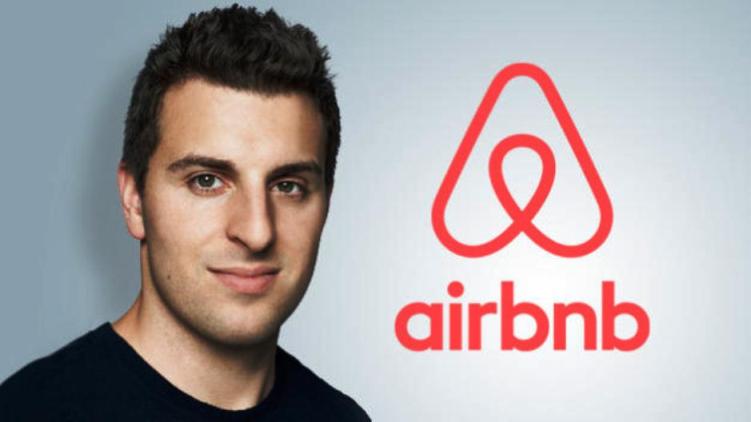
Co-founder & CEO Airbnb Brian Chesky (source: moneyinc.com)
Brian Chesky (38) is the co-founder and CEO of Airbnb, the vacation rental online marketplace which disrupted the hospitality industry.
Brian launched Airbnb in 2008 after he and his co-founders rented out an air mattress in their living room, effectively turning their apartment into a bed and breakfast, to offset the high cost of rent in San Francisco. Airbnb is a shortened version of its original name, AirBedandBreakfast.com.
The company’s mission is to connect people to unique travel experiences and create a world where anyone can belong anywhere.
AIRBNB STATISTICS
Airbnb offers over 7 million accommodations and 50,000 handcrafted activities, all powered by local hosts. The platform helps them monetize their spaces while keeping the financial benefits of tourism in their own communities.
The company brands itself as an economic empowerment engine promoting people-to-people connection, community and trust around the world.
The top 3 countries where Airbnb has had the highest impact are the U.S. ($33.8 billion), France ($10.8 billion) and Spain ($6.9 billion).
2 million people are staying on Airbnb per night on average with an all-time number of arrivals of 750 million people.
There are 2.9 million hosts in 200 countries worldwide. The company charges a 3% service fee for hosts and provides a $1 million protection for property damage.
With the travel and hospitality industry affected globally by the coronavirus pandemic, the company was forced to take drastic measures to adapt to new circumstances.
In a letter sent to Airbnb employees in May, Brian announced that he had to reduce the size of the Airbnb workforce.
The company laid off nearly 1,900 employees (around 25% of its staff) and expects its 2020 revenue to amount to half of last year’s, around $2.4 billion.
Brian also mentioned that in order to survive, the company will need to evolve accordingly and reduce the investments in activities that do not directly support the core of its host community.
“We don’t know exactly when travel will return and when travel does return, it will look different”, says Brian.
As of 2020, the company’s valuation has dropped to $26 billion.
6. EVAN SPIEGEL, co-founder & CEO of SNAPCHAT ($32.29 billion)
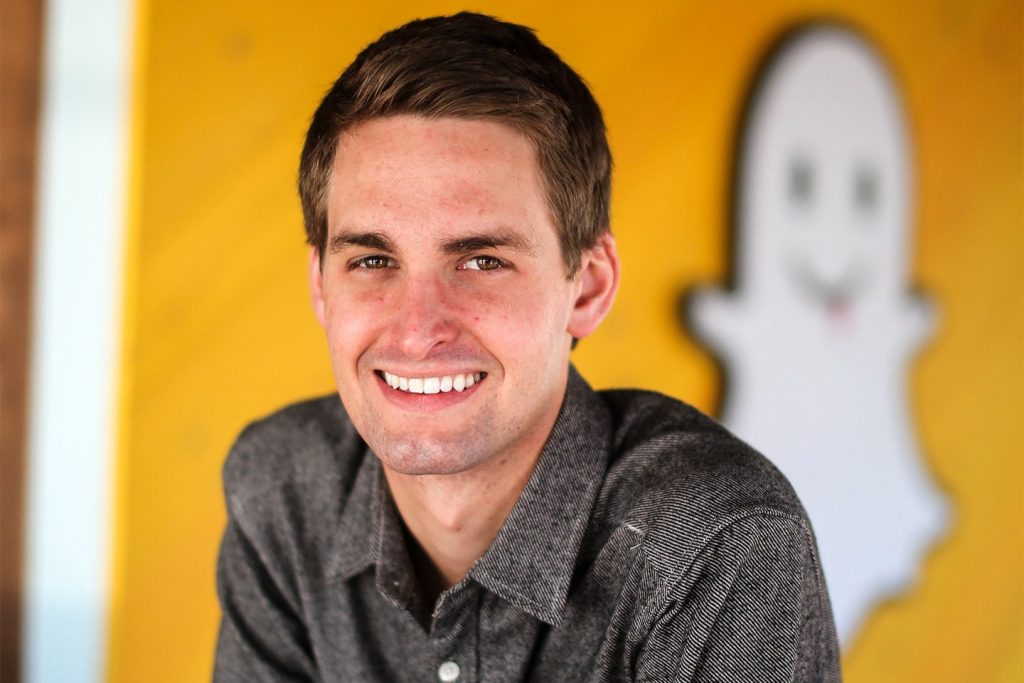
Co-founder & CEO Snapchat Evan Spiegel (source: medium.com)
Evan Spiegel (30) is the co-founder and CEO of Snapchat. He launched the famous app while still a student at Stanford University. Although his idea of an app with ephemeral messaging was ridiculed by his classmates, the undeterred Evan launched it in 2011. It was a prototype named Picaboo and within just one year, the app now renamed Snapchat had reached 1 million daily active users.
Facebook and Google offered Evan and his co-founders $3 billion and $30 billion respectively to buy Snapchat. Both offers were turned down. Snapchat is now valued at $32 billion.
SNAPCHAT STATISTICS
In 2019, Snapchat had almost 300 million monthly active users and generated $1.7 billion in revenue.
A pioneer of augmented reality, Snapchat brought the technology to the mainstream via its filters.
Over 75% of Snapchat users engage with augmented reality daily (180 million in Q2 2020).
The average Snapchat user sends 34 snaps per day and spends 30 minutes daily using the app.
Snapchat daily video views average of 10 billion.
In 2018, the company launched Snapchat Originals featuring original video content shot for Snapchat specifically by established names such as NBCUniversal, the BBC, ABC and Metro-Goldwyn-Mayer. For 2019, Buzzfeed was announced as one of the app’s contributors. Seeing that one of the Snapchat Originals series, Endless Summer counted 28 million viewers over its first series, it looks like this type of offering was a good business decision.
Last year also saw the launch of a new product, Snap Games – a new social gaming platform within the app. According to Phil Larsen, head of Snap Games, more than 100 million Snapchatters have played Snap Games globally.
7. PATRICK COLLISON, the co-founder of STRIPE ($36 billion)
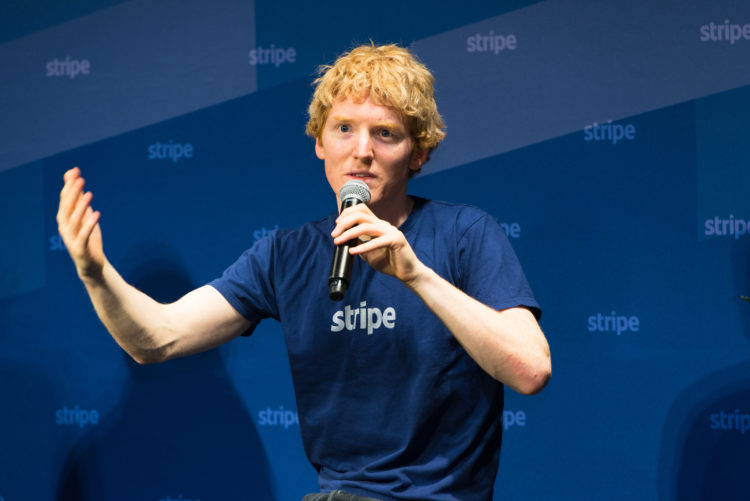
Co-founder and CEO Stripe Patrick Collison (image: startup365.fr)
Stripe is a technology company that builds economic infrastructure for the internet. Businesses of every size use the company’s software to accept payments and manage their businesses online. The company’s mission is to increase the GDP of the internet.
Patrick Collison co-founded Stripe in 2010 after receiving investment from PayPal co-founder Peter Thiel, Elon Musk and Sequoia Capital whose investments focus mainly on tech companies.
Stripe provides solutions for eCommerce & retail, B2B platforms, software as a service, B2C marketplaces, non-profits & fundraising.
STRIPE STATISTICS
Millions of companies in over 120 countries use Stripe to start, run, and scale their businesses. Some of the largest companies in the world are Stripe users such as Google, Amazon, Uber, Microsoft, Nasdaq, National Geographic, Facebook, Zoom and Salesforce.
More than 100,000 platforms are using Stripe Billing to manage subscriptions and invoices and 90% of US adults have bought from businesses using Stripe.
Stripe-hosted invoices get paid 3x faster than typical invoices.
Businesses recover 41% of failed payments through Stripe’s automatic card updates and smart retries.
For businesses that launched on Stripe since the onset of the coronavirus in the US, Stripe will shortly have facilitated $1 billion in sales.
The company’s machine learning models train on billions of data points and help increase revenue across conversion, fraud, revenue recovery, and more.
The company is also running an environmental program aiming to mitigate the threat of climate change. To this goal, Stripe announced this year its Negative Emissions Commitment by pledging at least $1 million per year to pay, at any price, for the direct removal of carbon dioxide from the atmosphere.
With $2 billion on its balance sheet, Stripe is valued at $36 billion.
8. DREW HOUSTON, co-founder & CEO of DROPBOX ($8 billion)
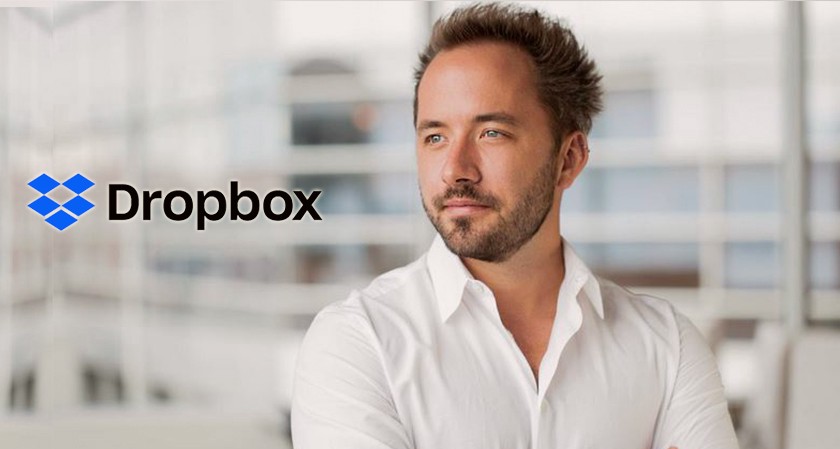
Dropbox co-founder & CEO Drew Houston (image: medium.com)
Drew Houston (37) co-founded Dropbox in 2007 while a student at MIT when he got fed up with the lack of seamless storage solutions for his files.
Although Dropbox began thirteen years ago as a file hosting service provider, today the platform defines itself as a smart workspace which limits the noise and complexity so users can focus on work that matters.
Dropbox brings together content, tools, people and conversations in a single digital environment.
Also, the platform uses Artificial Intelligence to suggest users which content they will need for a meeting or which content might be relevant to a document they are editing. Users are provided with a new way to work where they can stay focused and manage their team efficiently.
What type of work do Dropbox users accomplish with the platform’s tools? One example is filmmaking.
I was surprised to learn that Dropbox was an essential part of the process of shooting Motherless Brooklyn, the latest film of Oscar-nominated Edward Norton.
Dropbox also helped the creators of McMillions, the HBO documentary series, with organizing a massive amount of information that piled up over years of investigation.
And partnered with visual artist Solange, Beyonce’s sister to bring to life Bridge-s, her curated, programmed, and creative-directed series of performances, films, and artist talks.
The company’s business model is based on free, individual and business subscription plans. Dropbox offers two plans: for freelancers and solo workers and for business and teams of any size.
For 2019 the company generated $1.7 billion in revenue.
DROPBOX STATISTICS
- More than 450,000 teams use Dropbox Business;
- 4.5+ billion connections have been created through Dropbox shared folders and links;
- 56% of the Fortune 500 have at least one Dropbox team within their organisation;
- Over 600 million registered users;
- 14.6 million paying users;
- 80% of subscribers use Dropbox for work.
Join the Conversation
We’d love to hear what you have to say.
Get in touch with us on our LinkedIn Group, Facebook Group or Twitter.
8 Millennials running billion-worth tech companies (part 1)
8 Millennials running billion-worth tech companies
1. ADAM D’ANGELO, the co-founder of QUORA ($2 billion)
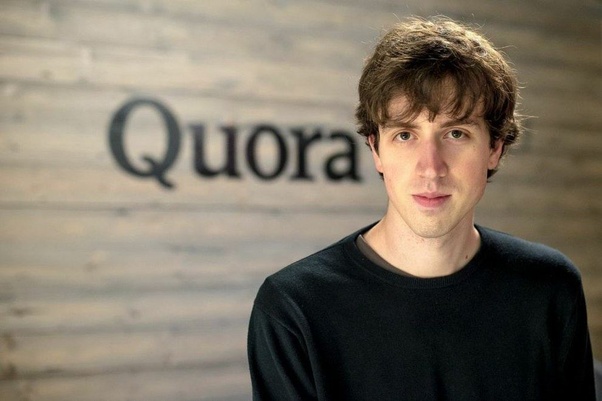
Quora co-founder Adam D’Angelo (source: vox.com)For Adam D’Angelo, 36, co-founder and CEO of Quora, “access to knowledge is one of the main ways we benefit from everyone who has come before us, and sharing knowledge is one of the most impactful ways to contribute back to society and future generations.”
After serving as Facebook’s CTO until 2008, Adam launched Quora, the crowdsourced question and answer platform in 2009. In 2014, Quora received $226 million and is now valued at $2 billion.
Adam wants to keep building the Q & A social platform that helps people learn while avoiding the controversies underlining his former employer’s ongoing trials and tribulations. So far he has succeeded.
How does Quora generate revenue? Advertisers run ads on specific questions or topics.
The company reported $8 million in revenue in 2018, with 300 million unique monthly visitors asking and answering questions in 24 languages.
Are you a Quora fan?
You can attend the Quora World Meetup Week 2020. The meetup will be held online and will take place August 8-16. If you are interested, check this blog announcement for more information.
QUORA STATISTICS
- 300 million unique monthly visitors;
- Adults spend 2x as much time on Quora than LinkedIn;
- Businesses using Quora Ads have seen up to 4x more conversions;
- 27% of Marketers plan to invest more in Quora Ads for 2020;
- In 2018, entertainment, travel, business, marketing, learning, and technology were the most popular topics on Quora.
2. ALEXIS OHANIAN, the co-founder of REDDIT ($3 billion)
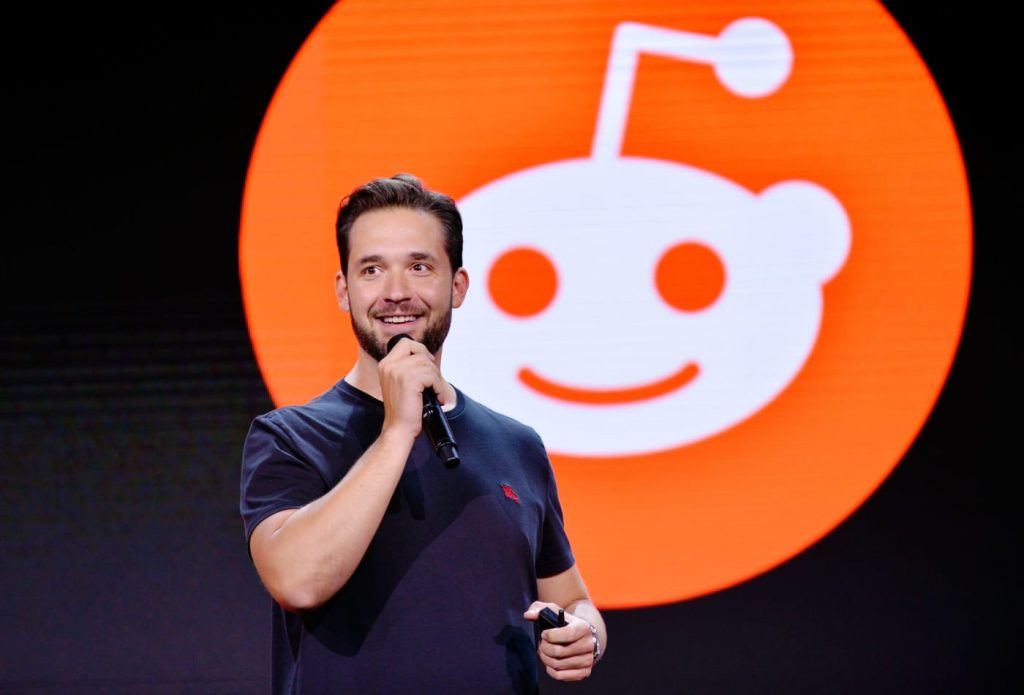
Co-founder of Reddit Alexis Ohanian (source: cnbc.com)
Alexis Ohanian (37) is the co-founder of Reddit, the social news aggregation, web content rating, and discussion website.
He launched Reddit in 2005, right after college with the goal of it becoming the “front page of the Internet.”
Fifteen years later, whether or not Reddit has accomplished its objectives is an open discussion.
What we do know is that the platform is now valued at $3 billion with its latest investment coming from Chinese company Tencent.
Reddit makes money by selling advertising space and from an optional premium membership plan that allows users to turn off ads and enjoy other benefits.
In 2018, Reddit made $100 million in ad revenues and for last year, the market analysts have forecast $119 million.
Amid the turmoil caused by the killing of George Floyd and the black lives movement going global, Alexis resigned from Reddit’s board and urged them to replace him with a black candidate as his contribution to fighting against racism. A bold and unique decision in the business space.
REDDIT STATISTICS
Reddit is a growing community with 430 million monthly active users and more than 100K active discussion forums.
From news to relationships, funny memes to beauty care, politics to anti-vaxxers – Redditors talk about everything.
The platform has also taken the Ask Me Anything (AMA) content to a whole new level. The top 3 most upvoted AMAs of 2019 featured Bill Gates, the Cookie Monster and Presidential Candidate Andrew Yang.
Discover more about Reddit’s top communities, trends and topics of the year in Reddit’s 2019 Year in Review.
3. MELANIE PERKINS, the co-founder of CANVA ($6 billion)
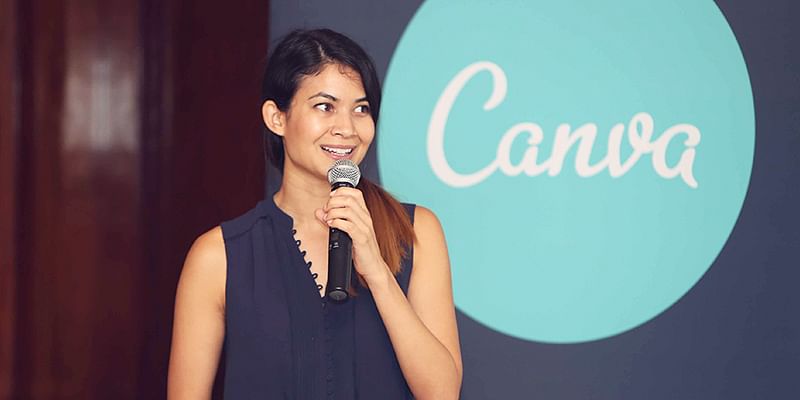
Co-founder of Canva Melanie Perkins (source: yourstory.com)
Co-founder Melanie Perkins (32) launched Canva in 2012 with one mission – to empower everyone to create beautiful designs without friction.
Canva provides graphic design software as a service; it is an online collaborative platform dedicated to people who aren’t graphic designers and don’t have funds to hire one.
Melanie and her team designed a great product which has rapidly become successful through word-of-mouth, social currency and listening to users feedback. Learn more: How Canva acquired 10 million users within 5 years.
Canva’s business model is subscription-based. The platform makes money from freemium subscriptions, prints, online and in-person design classes, design marketplace and an affiliate program. For the fiscal year 2019, Canva projected to hit annual revenues of $291 million.
CANVA STATISTICS
As of 2019, Canva has over 20 million users across 190 countries and is valued at $6 billion.
The latest news from Canva reports that users have created over 2 billion designs in more than 100 languages in the last year. To date, there have been 3.5 billion images uploaded to the platform.
4. BEN SILBERMANN, the co-founder of PINTEREST ($12.7 billion)
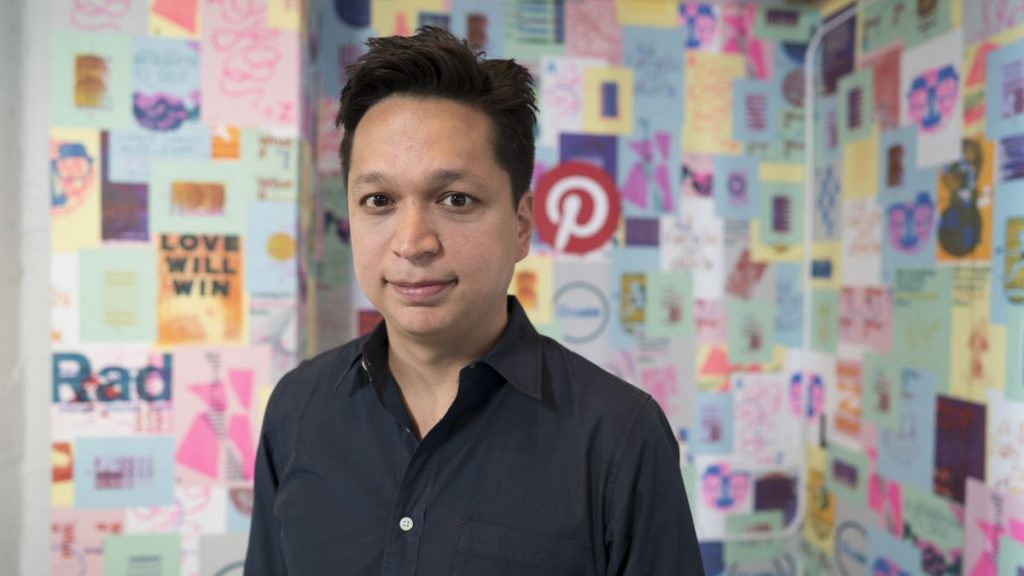
Co-founder of Pinterest Ben Silbermann (source: cnn.com)
Co-founder Ben Silbermann (38) launched Pinterest ten years ago as an online “catalogue of ideas”.
Pinterest is the visual discovery engine whose mission is to give everyone the inspiration to create a life that they love.
In 2019, Pinterest generated $1,14 billion in ad revenue with a 51% growth year-over-year compared to 2018.
PINTEREST STATISTICS
The platform boasts 367 million monthly active users and 48% of them are on the platform to shop which should be an interesting statistic for brands looking to reach their customers.
The users carry out more than 2 billion searches every month saving more than 200 billion pins to date. Half of the users live outside the US.
The number of active advertisers on Pinterest doubled in 2019 which is an indication that brands running ads on the platform are seeing positive results. Pinterest is constantly working on improvements to its advertising tools.
In its 2019 letter to shareholders, Pinterest mentions that it is making it much easier to discover and buy the products within the platform by improving and simplifying the user’s shopping experience.
Launched in 2018, video content has seen a 6x increase in viewership. The platform’s improved conversion visibility led to a 2,5x growth in attributed conversions for some advertisers.
For 2020, Pinterest expects total revenue of up to $1.52 billion. Currently, the visual discovery engine is evaluated at $12 billion.
The article continues with part 2.
Join the Conversation
We’d love to hear what you have to say.
Get in touch with us on our LinkedIn Group, Facebook Group or Twitter.
The No.1 shopping platform among Millennials
250 million people go to Pinterest for new ideas and inspiration.
Here 5 STATISTICS on this social media platform:
How Luxury Marketing Will Look Like in 2018
The concept of luxury is changing, just like everything we are surrounded by is, like our preferences and sometimes passions. Consumer expectations of luxury continue to rise, and that what used to be luxury is now seen by the current generation of consumers, everyday experiences. And, as always, technology has a big part in this change as it makes everything easier,closer and more affordable, therefore what some years ago was considered luxury today might not be so. And just like what today is luxury in the years to come might not be anymore. The definition of luxury is changing, while “upper luxury” appears.
According to Deloitte’s “Global Powers of Luxury Goods 2018”, the world’s 100 largest luxury goods companies generated sales of US$217 billion in FY2016 and the average luxury goods annual sales for Top 100 companies is now US$2.2 billion. The report discusses the trends and issues that are driving the luxury industry. It also identifies the 100 largest luxury goods companies based on publicly available data for FY2016 (which they define as financial years ending within the 12 months to June 2017), and evaluates their performance across geographies and product sectors.
The growing importance of non-western markets for the luxury goods industry has been supported by supply chain leadership, technological innovation and international investment. These factors will help maintain further strong
growth in these geographical markets.
Deloitte’s “Global Powers of Luxury Goods 2018” points out:
Luxury brands have refocused their business strategies to capitalise on these changes. Giorgio Armani is engaged in an in-store installation collaboration agreement with Colombian artist Marta Luz Gutiérrez, while Louis Vuitton is conducting an advertising campaign using a
building designed by the late Mexican architect Luis Barragán. Rising prosperity in major cities and growing formal market power over the black market will ensure sustained Rest of the World (ROW) demand for luxury goods. To succeed in this context, luxury players should focus their investments on digital connectivity, upwardly mobile consumers and bold business models, which are key components of the
personal luxury industry today.
Some aspects that marketers must pay attention and act on in 2018:
Still according to Deloitte, collectively, Millennials and Generation Z will represent more than 40 per cent of the overall luxury goods market
by 2025, compared with around 30 per cent in 2016. Unlike Baby Boomers, many Millennial luxury consumers expect to interact with brands across a range of digital platforms, rather than only through traditional channels. Millennial consumers are also important for in-store shopping and expect a high-value, customized experience. Luxury brands should seek to change their business models to meet this demand, for example by providing more loyalty
programs and invitations to in-store events.
Customize your approach according to your audience. Personalization is still key as a marketing technique to be used as 45% of luxury consumers are asking for personalized products and services. With different expectations, younger
shoppers seek a personalized shopping experience that seamlessly integrates both online and offline platforms. This shift has motivated demand for connective technology such as Augmented Reality (AR) and Artificial Intelligence
(AI). By using AR and AI technologies, luxury brands can provide a personalized consumer experience, reach a wider audience, deepen product experience, and build stronger customer relationships. In parallel, the development of technologies such as voice commerce and the Internet of Things (IoT) are reshaping the entire luxury industry.
Luxury brands positioned as reliable sources of AI-driven recommendations are improving how they engage with consumers. More widespread adoption of AI is also making consumers increasingly reliant on suggestions and advice
provided by their various devices, rather than making decisions based on personal experience.
Social media becomes an important marketing tool for luxury as well. Instagram became the leading social media platform for fashion designers. Gucci more than doubled its Instagram followers between 2016 and March 2018, with successful Insta-campaigns such as #TFWGucci.
In future, the biggest challenge for luxury brands will be to make optimum use of social media without compromising their brand values. The success of a social media strategy will be converting “likes” into an interactive and engaging experience for customers.- Deloitte
An omnichannel approach – onnichannelluxury
A true omnichannel global market environment would require luxury brands to close gaps in customer experiences across channels, to offer a seamless, unified brand experience irrespective of the device or physical touchpoint used. Therefore, each channel needs to interact with and support
others to establish a single brand presence. Demand for an omnichannel approach is a natural development from the spread of digital technology and
e-commerce markets. During this process of change, the ability of luxury brands to leverage available inventory will be a key differentiator.
Digital must remain a priority to define an omnichannel strategy compatible with target expectations. The percentage of online sales perceived as being additional, and not a cannibalization of, physical sales is decreasing each year, with China the least cannibalized country to date.
“Luxury brands should develop their mobile strategy: 55% of luxury consumers buying online use their mobile phones versus personal computers. Peaks appear among the youngest generations and Chinese consumers, 75% and 77%, respectively, of whom use mobile. Social media and influencers are gaining power. For the first time, social media is the first source of information and the channel of primary impact used by true-luxury consumers, followed by magazines and brand websites. Five platforms (Facebook, Instagram, WeChat, Weibo, and QQ) are dominating the social media world, but Facebook is losing momentum to Instagram in the Western world and QQ is losing momentum to WeChat and Weibo in China,” states in “True-Luxury Global Consumer Insight”, the fifth edition of an annual study by The Boston Consulting Group (BCG) and Altagamma.
Millennials: Consumer Aspirations Are Disrupting Luxury
Collaborations with streetwear brands and artists are becoming the norm for Generation Zers and Millennials. “Collaboration covers demand for newness in a less risky way. It gives brands a cool edge and strengthens brand awareness as well as increases willingness to buy the brand. Collaboration is increasingly in demand and turns out to be a very effective purchasing incentive,” said Olivier Abtan, a partner in BCG’s Paris office and the global leader of the firm’s luxury, fashion, and beauty topic.
Unlike “absolute luxurers,” who buy luxury items exclusively, millennials do not hesitate to mix and match. According to BCG’s study, about 55% of this group trades down to buy handbags or T-shirts from cheaper brands, or mixes their style by buying sneakers and luxury shoes from luxury niche brands (including luxury sports). This trend appears to fulfill consumers’ need to create their own style. When they do look for different brands, it’s because luxury brands don’t have offerings in certain categories or because of the Millennials’ desire to have a unique style, express themselves, and seek out niche brands.
Use iconic personalities in your communication
With all the big changes, some things are meant to last and take the test of time. Chanel’s iconic marketing history began with a print advertisement for its perfume, Chanel No.5, in 1921. Its first celebrity endorsement didn’t feature until 1954, with Marilyn Monroe. However, it wasn’t until 2005 when Chanel first adopted videography, and from here, the rest is history.
“Despite not adopting social media and integrating the platform with videography until 2009, its marketing strategy is nothing short of stupendous. Selecting admirable public figures such as Keira Knightley and Nicole Kidman to star in Chanel’s unmistakable short films, revived the brand as an iconic symbol of both cultural and digital relevance. With the use of video and social media integration, Chanel has grown to having more than 57 million social followers globally, the highest in the luxury fashion industry. The brand focused on Facebook as their initial social media platform, due to the video capabilities such as extended video length, that Twitter and Instagram do not support. For the brand’s primary consumer, the more wealthy and mature client, Facebook was the ideal platform for accessing this demographic,” wrote Little Agency.
Sensory Branding
According to Retail Insider, British Airways is encashing big on a recent study on sensory sciences by Oxford about how sound influences the taste of food. Based on the findings of this study, they launched a list of 13 in-flight tracks to enhance the taste of the meals served during the flight, providing a truly luxurious experience. Moreover, Soundwich in Portugal delivered gourmet sandwiches packed in metal boxes that play music chosen by the chef when opened.
More ideas you can see here.
How to talk to the Millennials in 2018
A study from Pew Research found that only 40 percent of Millennials even identify with the word “millennial,” compared to nearly 80 percent of those aged 51 to 69 who consider themselves part of the Baby Boomer generation.”I also find this generation to be more focused on describing themselves as individuals (hence the rise in “personal branding” as a career skill) than as members of a massive group. This begs the question: what should we call this cohort if not the M-word? Clearly I do use the term millennial because it’s helpful to have some sort of terminology, but I use it in a respectful fashion, realizing that most Millennials don’t care for any group name at all,” wrote Lindsey Pollak on her blog where she describes herself as being “Millennial workplace expert”.
Millennials are different than prior generations,but so does every generation. They are more comfortable with specific technologies, and they have their own perspective on the world that’s informed by both their individual and collective experiences. We believe that in 2018, every company representative has to realize that when he /she talks about Millennials, they are talking about a group of people that includes millions of homeowners, parents, and even people who are realizing that retirement isn’t just an abstract concept. “If your association is failing to reach Millennials, it’s because you haven’t figured out how to deliver or articulate your value to a group of people living very adult lives with very adult worries and concerns,” wrote thesentergroup.com.
At the end of the day, it’s important for managers, marketers and recruiters to understand that using the word as a descriptor (as in “millennial-focused office”) will rarely come off positively. Young professionals prefer terms like “emerging professionals” or “next generation” when referring to their age group in the workplace. And how do they like to be addressed by brands and companies? According to Courtney Wachob,writer for “Leading Results”, Millennials want the brands and companies’ representatives to speak the social media language, to appeal to their values, be authentic, not boring and listen to them. Sounds pretty clear and easy, no?
“Millennials do not want to be sold – and they can spot an advertisement/paid endorsement from a mile away. They recognize “marketing speak” and don’t want anything to do with it, so your content, messages, videos, etc. have to be real. If it looks like an ad, they’ll swipe left faster than on a Tinder profile without a picture. Figure out your authentic voice and use it to connect with – versus market to – them. Millennials are early adopters, seeking fresh ideas, innovative approaches, original insights and, of course, new technology. For Millennials, newer is better; they thrive on testing new devices and jump at the release of a new smartphone, social media platform, video game system, etc, ” explained Wachob in her article.
Creating workspaces that are attractive to millennials from CNBC.
The “Substitute Phone” and its therapeutic approach role
A recent report showed that 38% of American smartphone owners never disconnect from their devices and over 71% of them sleep with their phones next to their beds. As these devices become a necessity, the media industry is trying to figure out how to best deliver content on this platform and to cross-pollinate with existing platforms. In this context, Sylvia Chan-Olmsted, professor in the department of telecommunication at the University of Florida, whose research expertise includes digital/mobile media consumption, branding, and strategic competition in emerging media/communications industries, started a study focused on examining the relationship between smartphone dependency and a consumer’s media consumption patterns and perceptions. Surveying young Millennials, Sylvia found that:
- There is a strong relationship between a young adult’s dependency on smartphones and his or her dependency on computer and television. But that’s not the case for radio or print dependency.
- There is also a strong relationship between a young adult’s multiplatform use and their smartphone dependency, as well as its use as an anchor platform during multiplatform media consumption.
- Gender, race, and even consumer innovativeness do not play any role in smartphone dependency.
As shown here, she and Dr. Chan-Olmsted also found that the mobile functions that are most relevant to smartphone dependency for young Millennials were those associated with social networking, communication, and mobile-specific tasks such as location-based applications, but not content.
Austrian designer Klemens Schillinger created the Substitute Phone as a way to help smartphone addicts cope in its absence.
Schillinger told Dezeen , quoted by The Verge, that more and more, phones are becoming an addicting object in our lives. Users constantly play with them, even if they’re not looking for a message or expecting a call, and he was inspired to design “a tool that would help stop this ‘checking’ behaviour.” Therefore, Schillinger designed five facsimile phones, made of black polyoxymethylene plastic with stone beads embedded in the surface, which allows a user to replicate familiar actions, such as scrolling, pinching, or swiping. The goal is that it could be used as a coping mechanism for someone trying to check their phone less.

“The object, which some of us describe as a prosthesis, is reduced to nothing but the motions,” explains Schillinger’s description of the… object. “This calming limitation offers help for smartphone addicts to cope with withdrawal symptoms. The object as a therapeutic approach,” also wrote TechCrunch.
How to lead the Millennials with Simon Sinek
According to Simon Sinek, Millennials are no different when it comes to what they way, in comparison with any other generation, the only difference being that Millennials are the first generation with the guts to ask for it and to expect it.
Here are some of Simon’s ideas on how to lead the Millennials:
- Youth should reduce their exposure to technology, specifically cellphones. There is a strong correlation of addiction with technology and the dopamine cellphones release in our brains. That awareness was part of their climb to such global success.
2. In a 2012 study, Harvard research scientists reported that talking about oneself through social media activates a pleasure sensation in the brain usually associated with food, money and sex. It’s why we count the likes, it’s why we go back ten times to see if the interaction is growing, and if our Instagram is slowing we wonder if we have done something wrong, or if people don’t like us anymore. The trauma for young kids to be unfriended it too much to handle. We know when you get the attention it feels good, you get a hit of dopamine which feels good which is why we keep going back to it. Dopamine is the exact same chemical that makes us feel good when we smoke, when we drink and when we gamble. In other words, it’s highly, highly addictive…
3. They care more about the short-term gains than the life of this young human being. We care more about the year than the lifetime. We are putting them in corporate environments that are not helping them build their confidence. That aren’t helping them learn the skills of cooperation. That aren’t helping them overcome the challenges of a digital world and finding more balance. That isn’t helping them overcome the need for instant gratification and teach them the joys and impact and the fulfillment you get from working hard on something for a long time that cannot be done in a month or even in a year.
4. There should be no cellphones in conference rooms. When sitting and waiting for a meeting to start, instead of using your phone with your head down, everyone should be focused on building relationships. We ask personal questions, “How’s your dad? I heard he was in the hospital.” “Oh he’s really good thanks for asking. He’s actually at home now.” “Oh I’m glad to hear that.” “That was really amazing.” “I know, it was really scary for a while there.” — That’s how you form relationships. “Hey did you ever get that report done?” “No, I totally forgot.” “Hey, I can help you out. Let me help you.” “Really?” — That’s how trust forms. Trust doesn’t form at an event in a day. Even bad times don’t form trust immediately. It’s the slow, steady consistency and we need to create mechanisms where we allow for those little innocuous interactions to happen.
5. None of us should charge our phones by our beds. We should be charging our phones in the living rooms. Remove the temptation. We wake up in the middle of the night because you can’t sleep, you won’t check your phone, which makes it worse. But if it’s in the living room, it’s relaxed, it’s fine. Some say “but it’s my alarm clock.” Buy an alarm clock. They cost eight dollars.
6. The most important sentiments any leader can express to someone in their charge is “I’ve got your back. There’s nothing you can break that I can’t help put back together. I believe in you even when you no longer believe in yourself.”
7. We organize ourselves around the people and companies who seem to share our values, the same way our ancestors organized themselves into tribes. The best leaders are the ones who can express their fundamental why.
Top 5 marketing campaign that failed in 2016
Sometimes, no matter how big the budget is, some marketing campaigns go completely wrong. There are a large number of reasons for those situations, some of them being the lack of proper research, of attention or just simple the agency’s use of juniors. Here are some of the last year’s biggest marketing mistakes:
Microsoft and the Millennials
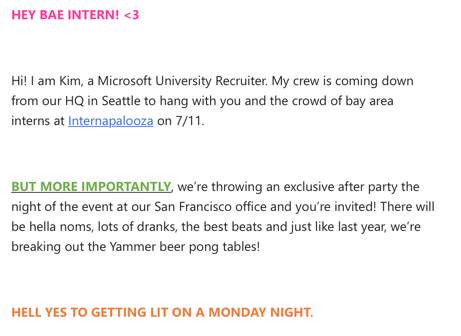
Microsoft’s latest attempt to recruit the next generation of engineering talent has backfired, as its rather awkward attempts at ‘Millennial speak’ have been roundly mocked on social media. In a bizarre effort to look hip, Microsoft promised “dranks,” “noms” and other buzzwords at a party for “bae interns.”
Jägermeister and the pool party that turns into chemical warfare
In Leon, Mexico, Jägermeister hosted a part in which its staff poured liquid nitrogen into the pool to ‘create a cool effect,’ an act which created a poisonous cloud, hospitalizing eight and putting one man into a coma. And that while the campaign’s tagline was: party responsibly.
Scott Disick’s Instagram fail
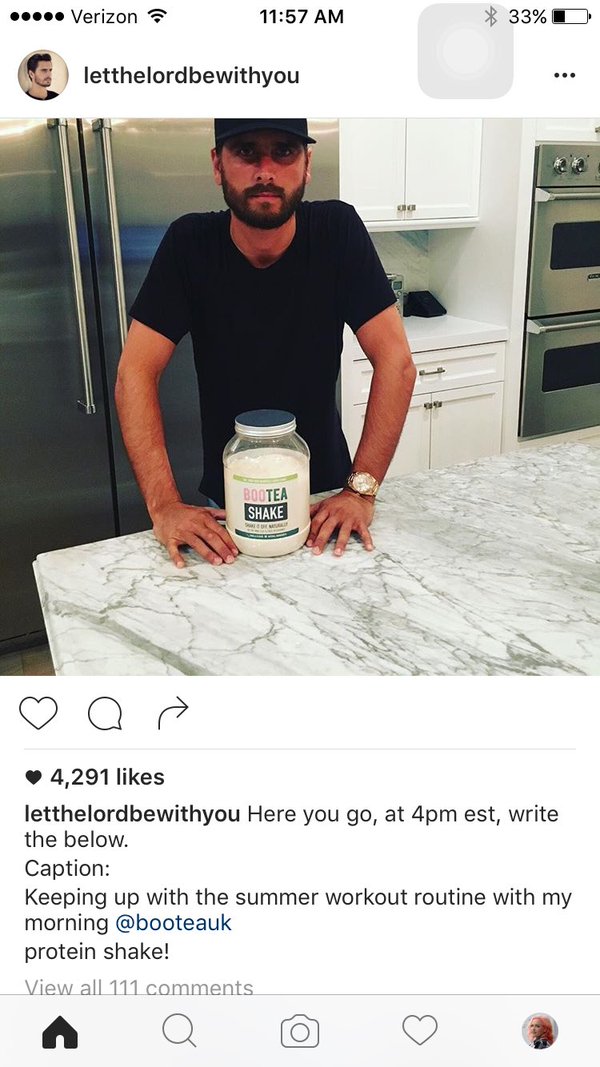
“Keeping Up With The Kardashians” star Scott Disick has become the subject of web ridicule after mistakenly including all the instructions his advertisers sent him on a paid Instagram post.
Microsoft AI Chatbot gone wrong
In March 2016, Microsoft created an artificial intelligence chat bot that talked like a Millennial and learned from humans. But its good intentions backfired, with rogue web users getting it to cite Hitler and support Donald Trump. The conversation extended to racist, inflammatory and political statements.
McDonald’s and the fitness tracker
McDonald’s fitness tracker happy meal toy was claimed to bring out its users in a rash. A McDonald’s US representative said the firm had decided to remove them “after receiving limited reports of potential skin irritations that may be associated from wearing the band”. Reports of skin irritation have derailed plans by McDonald’s to give out fitness trackers instead of toys in its Happy Meals. According to The Guardian, McDonald’s was hoping the Step It! Activity Band would be a means of getting kids to be more active, Digital Trends reported. The colorful plastic device strapped on like a watch and tracked steps. It blinked as the wearer walked and blinked more rapidly the faster they moved.
Warner Brothers reports its own website as illegal
Film studio Warner Brothers has asked Google to remove its own website from search results, saying it violates copyright laws. The requests surrounded movies like The Dark Knight, The Matrix and The Lucky One. In each of these instances, Warner Bros requested that its own official pages be removed from search results. It also asked the search giant to remove links to legitimate movie streaming websites run by Amazon and Sky, as well as the film database IMDB. The request was submitted on behalf of Warner Brothers by Vobile, a company that files hundreds of thousands of takedown requests every month.
Some more examples during the years, here.
